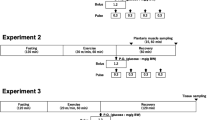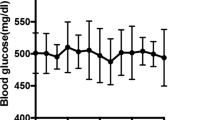Summary
The effect of physical training on glucose tolerance in vivo and skeletal muscle glucose metabolism in vitro was investigated in normal rats. Treadmill running for 10 days up to 240 min/day led to a decrease of basal and glucose-stimulated plasma insulin levels without major alterations of the IV glucose tolerance (1 g/kg body weight). Swim training of two weeks' duration, i. e. exercise up to 2×75 min/ day, which did not induce significant changes in body composition, skeletal muscle glycogen levels or citrate synthase activity, resulted in a significant improvement of IV glucose tolerance and substantial reductions of basal and glucose-stimulated plasma insulin levels. Associated with this apparent improvement of insulin sensitivity in vivo, significant increases of the insulin-stimulated glucose uptake (+ 55%) and lactate oxidation (+ 78%) in vitro were found on perfusion of the isolated hindquarter of swim-trained animals. It is suggested that mild physical training can improve glucose tolerance and insulin sensitivity in normal rats, at least in part, due to an increase of insulin sensitivity of skeletal muscle glucose metabolism.
Article PDF
Similar content being viewed by others
Avoid common mistakes on your manuscript.
References
Joslin, E. P.: The treatment of diabetes mellitus. In: Treatment of diabetes mellitus, 10th edition. Joslin, E. P., Root, H. F., White, P., Marble, A. (Eds.), pp. 243–300. Philadelphia: Lea and Febiger 1959
Berger, M., Berchtold, P., Gries, F. A., Zimmermann, H.: Die Bedeutung von Muskelarbeit und-training für die Therapie des Diabetes Mellitus. Dtsch. Med. Wochenschr.103, 439–443 (1978)
Berger, M., Berchtold, P., Cüppers, H. J., Drost, H., Kley, H. K., Müller, W. A., Wiegelmann, W., Zimmermann-Telschow, H., Gries, F. A., Krüskemper, H. L., Zimmermann, H.: Metabolic and hormonal effects of muscular exercise in juvenile type diabetics. Diabetologia13, 355–365 (1977)
Blotner, H.: Effect of prolonged physical inactivity on tolerance of sugar. Arch. Intern. Med.75, 39–44 (1945)
Lipman, R. L., Raskin, P., Love, T., Triebwasser, J., Lecocq, F. R., Schnure, J. J.: Glucose intolerance during decreased physical activity in man. Diabetes21, 101–107 (1972)
Mann, G. V., Garett, H.L., Farhi, A., Murray, H., Billings, F. T., Shute, E., Schwarten, S. E.: Exercise to prevent coronary heart disease. Am. J. Med.46, 12–27 (1969)
Montoye, H. J., Block, W. D., Metzner, H., Keller, J. B.: Habitual physical activity and glucose tolerance. Diabetes26, 172–176 (1977)
Hirsch, E. Z., Hellerstein, H. K., McLeod, A.A.: Physical training and coronary heart disease. In: Exercise and the heart, pp. 106–187. Springfield, Ill.: C. C.Thomas 1972
Björntorp, P., de Jounge, K., Sjöstrom, L., Sullivan, L.: The effect of physical training on insulin production in obesity. Metabolism19, 631–637 (1970)
Björntorp, P., Berchtold, P., Grimby, G., Lindholm, B., Sanne, H., Tibblin, G., Wilhelmsen, L.: Effects of physical training on glucose tolerance, plasma insulin and lipids and on body composition in men after myocardial infarction. Acta Med. Scand.192, 439–443 (1972)
Björntorp, P., de Jounge, K., Sjöström, L., Sullivan, L.: Physical training in human obesity. II. Effects on plasma insulin in glucose intolerant subjects without marked hyperinsulinemia. Scand. J. Clin. Lab. Invest.32, 42–45 (1973)
Björntorp, P., Holm, G., Jacobsson, B., Schiller-de Jounge, K., Lundberg, P.-A., Sjöstrom, L., Smith, U., Sullivan, L.: Physical training in human hyperplastic obesity. IV. Effects on the hormonal status. Metabolism26, 319–328 (1977)
Lohmann, D., Liebold, F., Heilmann, W., Senger, H., Pohl, A.: Diminished insulin response in highly trained athletes. Metabolism27, 521–542 (1978)
Vogel, A. I.: Practical organic chemistry, 3rd Edition, pp. 153–154. London: Longmans, Green and Co. 1961
Baldwin, K. M., Klinkerfuss, G. H., Terjung, R. L., Mole, P. A., Holloszy, J. O.: Respiratory capacity of white, red, and intermediate muscle: adaptive response to exercise. Am. J. Physiol.222, 333–378 (1972)
Srere, P. A.: Citrate synthase. Methods Enzymol.13, 3–5 (1969)
Ruderman, N. B., Houghton, C. R. S., Hems, R.: Evaluation of the isolated perfused rat hindquarter for the study of muscle metabolism. Biochem. J.124, 639–651 (1971)
Berger, M., Hagg, S. A., Ruderman, N. B.: Glucose metabolism in perfused skeletal muscle. Interaction of insulin and exercise on glucose uptake. Biochem. J.146, 231–238 (1975)
Berger, M., Hagg, S. A., Goodman, M. N., Ruderman, N. B.: Glucose metabolism in perfused skeletal muscle. Effects of starvation, diabetes, fatty acids, acetoacetate, insulin and exercise on glucose uptake and disposition. Biochem. J.158, 191–202 (1976)
Kemmer, F. W., Berger, M., Herberg, L., Gries, F. A.: Effects of metformin on glucose metabolism of isolated perfused rat skeletal muscle. Drug Res.27, 1573–1576 (1977)
Bergmeyer, H. U., Bernt, E.: D-Glucose Bestimmung mit Glukose-Oxydase und Reoxydase. In: Methoden der enzymatischen Analyse. Bergmeyer, H. U. (Ed.), pp. 1172–1176. Weinheim/Bergstraße, West Germany: Verlag Chemie 1970
Herberg, L., Kley, H. K.: Adrenal function and the effect of a high fat diet on C57B1/6J and C57B1/6J-ob/ob mice. Horm. Metab. Res.7, 410–415 (1975)
Kemmer, F. W., Berger, M., Herberg, L., Gries, F. A., Wierdeyer, L., Becker, K.: Glucose metabolism in the fatty Zucker rat. Biochem. J. (in press)
Curtis-Prior, P. B., Tretheway, J., Stewart, G. A., Hanley, T.: The contribution of different organs and tissues of the rat to assimilation of glucose. Diabetologia5, 384–391 (1969)
Holloszy, J. O., Booth, F. W.: Biochemical adaptations to endurance exercise in muscle. Annu. Rev. Physiol.38, 273–291 (1976)
Fitts, R. H., Booth, F. W., Winder, W. W., Holloszy, J. O.: Skeletal muscle respiratory capacity, endurance, and glycogen utilization. Am. J. Physiol.228, 1029–1033 (1975)
Karlsson, J., Nordesjö, L.-O., Saltin, B.: Muscle glycogen utilisation during exercise after physical training. Acta Physiol. Scand.90, 210–217 (1974)
Saltin, B., Karlsson, J.: Muscle glycogen utilization during work of different intensities. In: Muscle metabolism during exercise. Pernow, B., Saltin, B. (Eds.), pp. 289–299. New York: Plenum Press 1971
Roch-Norlund, A. E.: Muscle glycogen synthetase in diabetic man. Acta Physiol. Scand. [Suppl.]358, 1–27 (1972)
Pruett, E. D. R.: Fat and carbohydrate metabolism in exercise and recovery, and its dependence upon work load severity. Academic Dissertation, Institute of Work Physiology, University of Oslo 1971
Soman, V., Koivisto, V., Grantham, P., Felig, P.: Increased insulin binding to monocytes after exercise: cellular mechanism of augmented insulin sensitivity. Diabetes27 [Suppl. 1], 449 (1978)
Holm, J. S. E.: Skeletal muscle metabolism in patients with peripheral arterial insufficiency. Academic Dissertation, Göteborg 1972
Gould, M. K., Rawlinson, W. A.: Effect of natural exercise on pentose transport in rat skeletal muscle. Am. J. Physiol.211, 147–150 (1966)
Author information
Authors and Affiliations
Rights and permissions
About this article
Cite this article
Berger, M., Kemmer, F.W., Becker, K. et al. Effect of physical training on glucose tolerance and on glucose metabolism of skeletal muscle in anaesthetized normal rats. Diabetologia 16, 179–184 (1979). https://doi.org/10.1007/BF01219795
Received:
Revised:
Issue Date:
DOI: https://doi.org/10.1007/BF01219795




